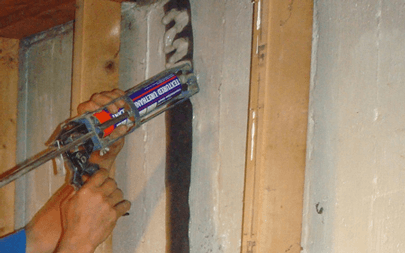Introduction
When it comes to maintaining the structural integrity of your home, addressing basement cracks is essential. These cracks can lead to water infiltration, compromising the foundation and potentially causing serious damage. Fortunately, there are various basement crack-filling techniques available to help mitigate these issues. In this article, we will explore different basement crack filling techniques and discuss their effectiveness. If you’re looking for crack-filling services in Lansing, MI, or a reliable crack-filling company in Lansing, this guide will provide you with valuable insights.
Common Causes of Basement Cracks
Basement cracks are a common issue that homeowners may encounter, and understanding their causes is essential for effective prevention and repair. Here are some of the most common causes of basement cracks:
- Settling of the Foundation: Over time, the soil beneath a home’s foundation can shift and settle, causing the foundation to move as well. This movement can result in cracks in the basement walls or floor. Factors such as soil composition, moisture content, and improper compaction during construction can contribute to foundation settling.
Wall Separating From Ceiling issues often arise as a consequence of foundation settling. When the foundation moves, it can cause the walls to shift, leading to visible cracks where the walls meet the ceiling. These cracks may start small but can worsen over time if not addressed promptly.
- Hydrostatic Pressure: Hydrostatic pressure refers to the pressure exerted by water against a basement wall or floor. It occurs when the soil surrounding the foundation becomes saturated with water, causing the water to push against the basement walls. This pressure can lead to cracks, especially in areas with poor drainage or inadequate waterproofing.
- Poor Construction: Inadequate construction practices or materials can contribute to basement cracks. Insufficient reinforcement, improper concrete curing, or the use of low-quality building materials can weaken the structural integrity of the basement walls or floor, making them more prone to cracking.
- Temperature Fluctuations: Extreme temperature changes can cause materials to expand and contract. In basements, this expansion and contraction can result in cracks. For example, during freezing temperatures, water within the soil can freeze and expand, exerting pressure on the foundation walls and leading to cracks.
- Poor Drainage: Inadequate or improper drainage around the foundation can contribute to basement cracks. When water is not effectively directed away from the house, it can accumulate near the foundation, saturating the soil and exerting hydrostatic pressure on the basement walls.
- Basement Drainage System installation is a crucial step in preventing such issues. This system involves various techniques such as interior drain tile installation, exterior French drains, or the use of sump pumps to efficiently divert water away from the foundation. By implementing a comprehensive basement drainage system, homeowners can mitigate the risk of basement cracks caused by water accumulation and pressure.
- Plumbing Leaks: Plumbing leaks within the basement can cause moisture accumulation and increase the likelihood of cracks. Water leakage from pipes, fixtures, or faulty drainage systems can weaken the surrounding materials and compromise the structural integrity of the basement.
- Natural Disasters: Natural disasters such as earthquakes or heavy storms can subject a home’s foundation to significant stress. The intense shaking during an earthquake or the pressure from excessive rainfall and flooding can result in basement cracks.
- Tree Root Growth: Trees planted too close to the foundation can cause basement cracks as their roots grow and expand. The roots can exert pressure on the foundation walls, leading to cracking over time.
- Basement Wall Crack Repair specializes in addressing these common causes of basement cracks, providing effective solutions to restore the structural integrity of your home’s foundation. Understanding the underlying factors behind basement cracks is the first step towards implementing long-lasting repairs and safeguarding your property against further damage.
Basement Crack Filling Techniques:
Epoxy Injection
Epoxy injection is a popular technique used to repair basement cracks. It involves injecting an epoxy resin into the crack, which fills and seals it, effectively preventing water penetration. The steps that commonly make up the procedure are as follows:
- a) Preparation: The crack is cleaned and prepared by removing loose debris and applying a surface sealant.
- b) Injection: An epoxy resin is injected into the crack, starting from the lowest point and working upwards.
- c) Curing: The epoxy resin cures and hardens, creating a durable seal.
Epoxy injection is effective for both structural and non-structural cracks, providing long-lasting results.
Polyurethane Injection
Polyurethane injection is another commonly used basement crack-filling technique. It involves injecting polyurethane foam into the crack, which expands and fills the void. This technique offers several advantages:
- a) Flexibility: Polyurethane is flexible, allowing it to accommodate slight movements in the foundation without cracking.
- b) Water-tight seal: The foam expands and fills the crack completely, creating a watertight barrier.
- c) Quick curing: Polyurethane foam cures rapidly, reducing downtime.
Polyurethane injection is particularly effective for sealing actively leaking cracks and is a reliable solution for preventing water infiltration.
Hydraulic Cement
Hydraulic cement is a popular choice for basement crack repair services, especially for larger cracks or areas with high water pressure. It is a fast-setting cementitious material that expands as it cures. The steps involved in using hydraulic cement for crack filling are:
- a) Preparation: The crack is cleaned and dampened with water.
- b) Mixing: The hydraulic cement is mixed with water to form a paste-like consistency.
- c) Application: The paste is pressed into the crack, ensuring it fills the entire void.
- d) Curing: Hydraulic cement cures quickly, typically within a few minutes.
While hydraulic cement provides an effective temporary fix, it may require periodic reapplication for long-term durability.
Carbon Fiber Reinforcement
For more severe structural cracks, carbon fiber reinforcement is often recommended. This technique involves applying carbon fiber strips or fabric over the crack to provide added strength and prevent further movement. The process includes the following steps:
- a) Surface preparation: The crack area is cleaned and prepared for adhesive application.
- b) Adhesive application: Epoxy or a specially designed adhesive is applied to the crack area.
- c) Carbon fiber installation: Carbon fiber strips or fabric are placed over the adhesive, covering the crack.
- d) Finishing touches: Additional layers of adhesive may be applied, and the surface is smoothed for a seamless appearance.
Carbon fiber reinforcement helps distribute the structural load and can effectively prevent crack propagation.
Conclusion
Basement crack filling is a crucial aspect of maintaining a structurally sound home and preventing water damage. Understanding different crack-filling techniques allows you to make an informed decision when choosing the appropriate solution for your basement. Whether you opt for an epoxy injection, polyurethane injection, hydraulic cement, or carbon fiber reinforcement, consulting with a reputable crack filling company Lansing, MI, will ensure professional and reliable results.
Common Causes of Basement Cracks
Cracks in Basement Floors can result from various factors, including foundation settling, soil movement, or water damage. Identifying the specific cause of these cracks is crucial in implementing targeted solutions to mitigate further damage.






























